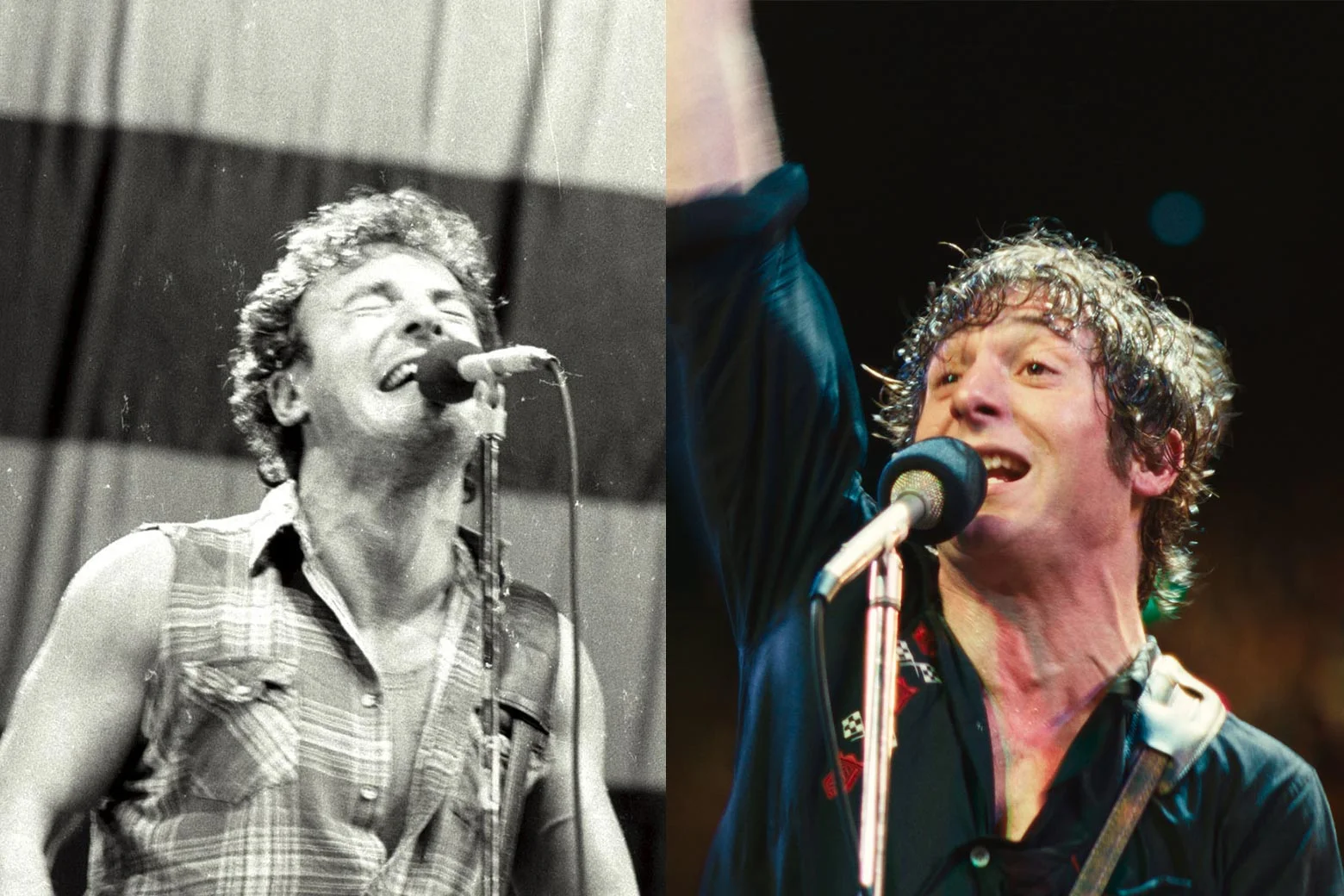Copyright Slate

It seems that a new rite of passage for millennial leading men is portraying rock icons of their grandfather’s—or even great-grandfather’s—generation. So to the roster of Rami Malek as Freddie Mercury, Austin Butler as Elvis, Taron Egerton as Elton John, and, of course, Timothée Chalamet as Bob Dylan, we must now add Jeremy Allen White in Springsteen: Deliver Me From Nowhere. But while these other actors are called on to evoke the musical talent and stage charisma of the artists they are portraying through filmic performances of a few greatest hits, the Springsteen film is short on this kind of fan service. There’s a bit of White-as-Bruce performing “Born to Run” in an arena, and a storming version of “Born in the U.S.A.” shot as a one-take studio recording, but other than White’s Springsteen jamming with a bar band, the master performer is conspicuous by his absence. This perhaps is just as well, considering that White began taking singing and guitar lessons only six months before shooting started. What White is very good at, though, is portraying a gifted but tormented artist wrestling with self-doubt. Only instead of The Bear’s Carmy Berzatto battling depression while sitting in his room scribbling mold-breakingly brilliant recipes, we have Springsteen battling depression while sitting in his room scribbling mold-breakingly brilliant lyrics for his highly personal acoustic album Nebraska. Deliver Me From Nowhere is thus not a conventional musical biopic but rather a look at one difficult year in an artist’s life leading to a creative breakthrough. It’s impossible to say for certain what’s going on in someone’s head (although, helpfully, Springsteen wrote an autobiography shedding some light on this), we nevertheless try to separate out fact from fiction in Deliver Me From Nowhere. Was Springsteen’s Father Abusive? Coming off the end of a long tour to promote his album The River, Bruce is at a crossroads, ambivalent as to whether he wants to pursue arena-level stardom or live a quieter life playing small venues and staying true to his New Jersey roots. He is haunted by ever-more-frequent memories of his childhood in the blue-collar town of Freehold, living in fear of the rages his father (Stephen Graham) would fly into after brooding drinking sessions at either a neighborhood bar or the kitchen table, and lying in his bed hearing his father beat up his mother. Eventually, he decides that, rather than work on the commercial album the record company is pushing for, he must first exorcise his demons through a very personal work. In fact, Springsteen’s father, Doug (also known as Dutch), did have a drinking problem and was abusive to his family. Douglas Springsteen had worked a number of blue-collar jobs, ranging from floor boy in a rug factory to prison guard and cab driver, all interspersed with periods of unemployment, which led to the family moving in with his wife’s parents. In Renegades: Born in the USA, a book Springsteen co-authored with Barack Obama in 2021, the musician wrote: “From when I was a young man, I lived with a man who suffered a loss of status and I saw it every single day. … It was all tied to lack of work, and I just watched the low self-esteem.” The result, Springsteen recalled in his 2016 memoir Born to Run, was a man who spent most evenings either at a local bar or at the family home, drinking on his own, “the silent, dormant volcano of the old man’s nightly kitchen vigil, the stillness covering a red misting rage.” All too often, that rage would be directed toward his shy, sensitive son, who, far from being an incipient hotshot rock star, preferred to spend time in his room writing and playing music, an inclination that led his father to dismiss him as an “outcast weirdo misfit sissy boy.” (A similar crucible produced the early songs of Brian Wilson, who was also afflicted with a bullying father.) Springsteen’s ultimate solution was to create a public/stage persona that was a sort of 1950s bad-boy artist along the lines of Jack Kerouac or James Dean, an idealized version of his father. As he writes in the memoir: I’m way into my 30s before I even have any idea that that’s my method of operation. I’m on stage. I’m in workmen’s clothes. I’ve never worked a job in my life. My dad was a beefy, bulky guy. I’ve played freaking guitar my whole life, but I’ve got 20 or 30 extra pounds on me from hitting the gym. Where’d that come from? Why do I spend hours lifting up and putting down heavy things for no particular reason? My entire body of work, everything that I’ve cared about, everything that I’ve written about, draws from his life story. Doug Springsteen was later diagnosed with paranoid schizophrenia, and his moods became steadier once he was able to start treatment with prescribed drugs as opposed to self-medicating with alcohol. This, plus Springsteen’s own years in therapy, allowed the singer to reconcile with his father. Did Jon Landau Rent a House for Springsteen? After Bruce returns from the long tour supporting The River, he has nowhere to live and asks Jon Landau, his faithful manager/album co-producer/fixer/sounding board/cheerleader and friend, for help. Jon finds a rental in Colts Neck, New Jersey, a glass-fronted house surrounded by trees overlooking a lake, and in September 1981, Bruce moves in. This is true, although the actual house was smaller than the serene mid-century-modern in the woods depicted in the film. It overlooked not a lake as such but the Swimming River Reservoir, where Springsteen was photographed ice-skating for the cover of Rolling Stone. Did Springsteen Really Record the Songs for Nebraska on a Four-Track Home Recording Machine? Rather than using his secluded new home to pursue classic rock star pastimes like hosting wild parties, Bruce embraces the isolation and becomes something of a recluse, withdrawing into his bedroom to sketch out songs that help him come to terms with his inner turmoil. He takes inspiration not only from his dark childhood memories but from other sources, like the teenage Charles Starkweather (whose killing spree, which left 10 dead in Nebraska and Wyoming, shocked 1950s America) and its filmic interpretation, Terrence Malick’s Badlands. He enlists tour roadie Mike Batlan (Paul Walter Hauser) to install a TEAC 144 four-track tape recorder, old-fashioned technology even in 1981, so he can make basic multitrack recordings at home on his own and hear what the songs sound like without anyone else around. After some months, Mike is dispatched to deliver a cassette with Nebraska’s highly personal, stripped-back tracks recorded with guitar and harmonica only, a far cry from the singles-packed, radio-friendly follow-up to Born to Run that record company executives at Columbia were expecting. The original plan was for the cassette version to act as a demo to help Bruce’s trusty E Street Band rerecord the songs in the studio; now Bruce wants to release the album using the original raw cassette tracks, despite the arcane and difficult task of transferring them to vinyl. Mike also conveys Bruce’s instructions for the album release—no press, no tour, and he doesn’t want to be on the cover. This is all true. Mike Batlan did install a TEAC 144 four-track tape recorder in Springsteen’s bedroom and later brought Landau a home cassette with the tracks. Springsteen did lay down those conditions, and Landau got Columbia to reluctantly accept them because the execs had already heard a tape of “Born in the U.S.A.” (the single) and wanted it enough to accede to Springsteen’s insistence that he get Nebraska out of the way first. As Landau said to Warren Zanes, author of the book Deliver Me From Nowhere: The Making of Bruce Springsteen’s Nebraska, which provided the source material for the film: “It’s like he had his Star Wars and his art movie in his hand at the same moment. And he went to Nebraska first. It’s just where he had to go.” Did Springsteen Continue Playing at a Local Asbury Park Bar Even After He Became a Big Star? In the film, when the walls of the Colts Neck house start closing in and Bruce feels blocked, he heads for a local music club called the Stone Pony. He is just as happy sitting in as a sideman with the house band, playing covers and familiar blues tunes, as he is playing arenas. This also is true. Bobby Bandiera, a member of Stone Pony regulars Cats on a Smooth Surface, is quoted in an oral history of the club: I remember the first night I met him, and it wasn’t the first night I’d seen him there, but it was the first night I met him. I said, “Hey.” He says, “I’m Bruce.” I said, “Yep. How you doing, brother?” And he says, “You mind if I come up and play?” I said, “No. Sure. Come up.” It’s the summer of ’81. He started coming up, having a good time, having a blast. Crowd was always electric when he showed up. Springsteen himself recalled that even after the huge success of Born In the U.S.A., “I had my white pickup truck, and I hopped in that old junker and I took it down to the Pony. And that’s where I spent my Fridays and Sundays and I had no interest in what was going on in New York City or L.A. I always said, ‘No, no, no.’ This is interesting. This is interesting to me. … What we do here matters. You’re sustaining a local scene.” Did Springsteen Have a Relationship With a Local Woman? One night as he’s leaving the Stone Pony, Bruce runs into an old acquaintance from high school and his sister, Faye (Odessa Young, in the Karen Black role as an Unfeasibly Good-Looking Diner Waitress), whom Bruce vaguely remembers from school. The two start seeing each other, with Bruce growing closer to Faye and her young daughter and getting a taste of what might have been if he had just stayed in Asbury Park and not obsessively developed his gift for music. But soon enough he’s cheating on her with his muse—ghosting her so he can stay home and write—and letting his fear of intimacy and commitment get in the way of his happiness. While he was writing Nebraska, Springsteen, who was single at the time, had a number of relationships, some of which may well have started at the Stone Pony. Nevertheless, it appears Faye is an imaginary character, possibly a composite. One woman he did meet at the club in the early ’80s, however, was Patti Scialfa, a musician and his future wife, although the two didn’t start dating until 1988, by which time she’d been a member of the E Street band for four years (and Springsteen had been married to and divorced from Julianne Phillips, an actress/model, not a diner waitress). Did Springsteen Have a Breakdown While Driving Across the Country? With Nebraska ready to be released, Bruce (or, rather, Jon acting for Bruce) buys a house in Los Angeles, where his parents are now living, and commits to putting out Born in the U.S.A. and seeing where the wave of fame will take him. He drives across the country with his old friend Matt, an auto mechanic. En route, they stop in at a small-town fair with its carnival rides and local band. Bruce has an episode of disassociation, and a worried Matt calls Jon, saying he’s never seen Bruce so low. After they arrive in L.A., Jon finally gets Bruce to see a therapist. This actually happened. In his autobiography, Springsteen recalls that he did have a breakdown at country fair and became detached from reality, writing that while he doesn’t know why he fell down the rabbit hole that night, “all I do know is as we age, the weight of our unsorted baggage becomes heavier … much heavier. With each passing year, the price of our refusal to do that sorting rises higher and higher.”



